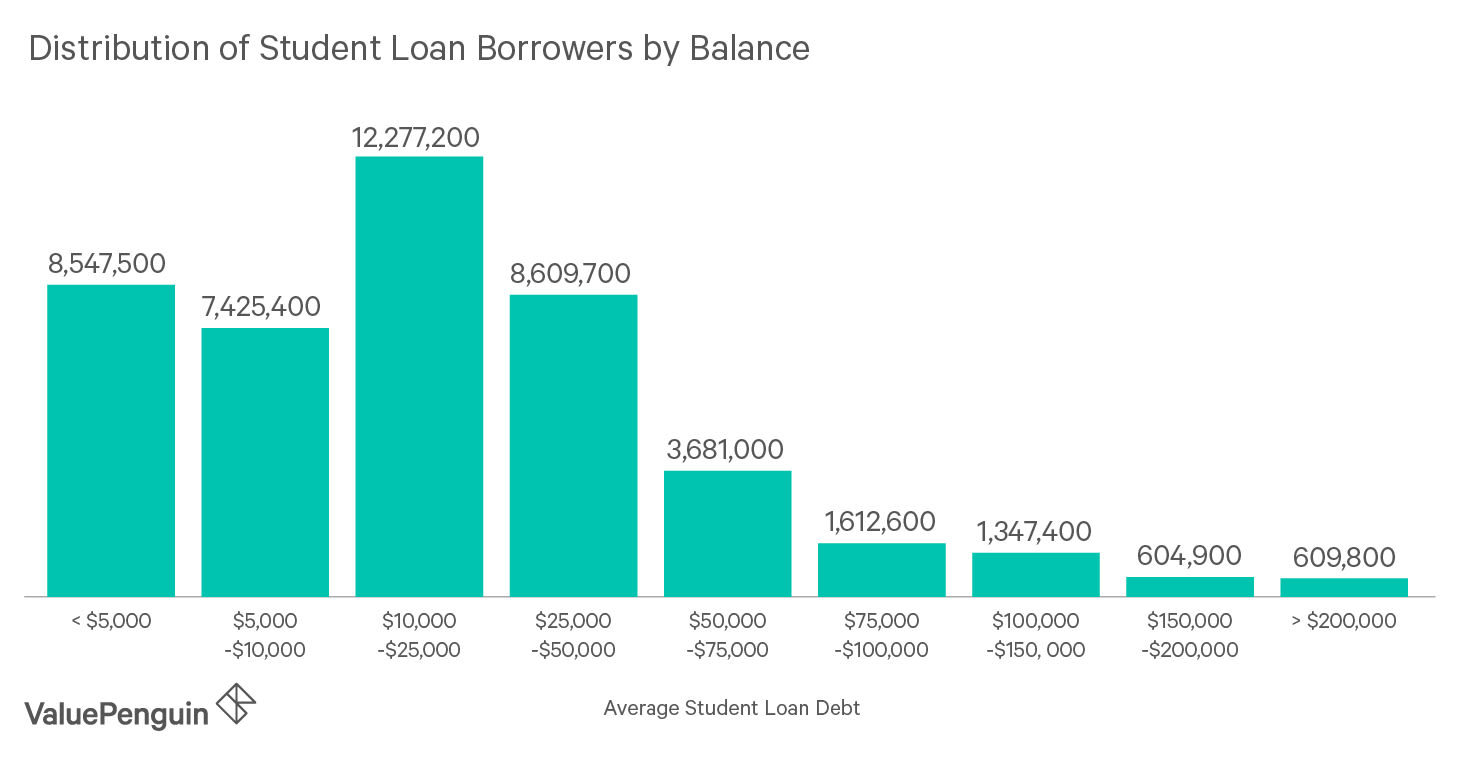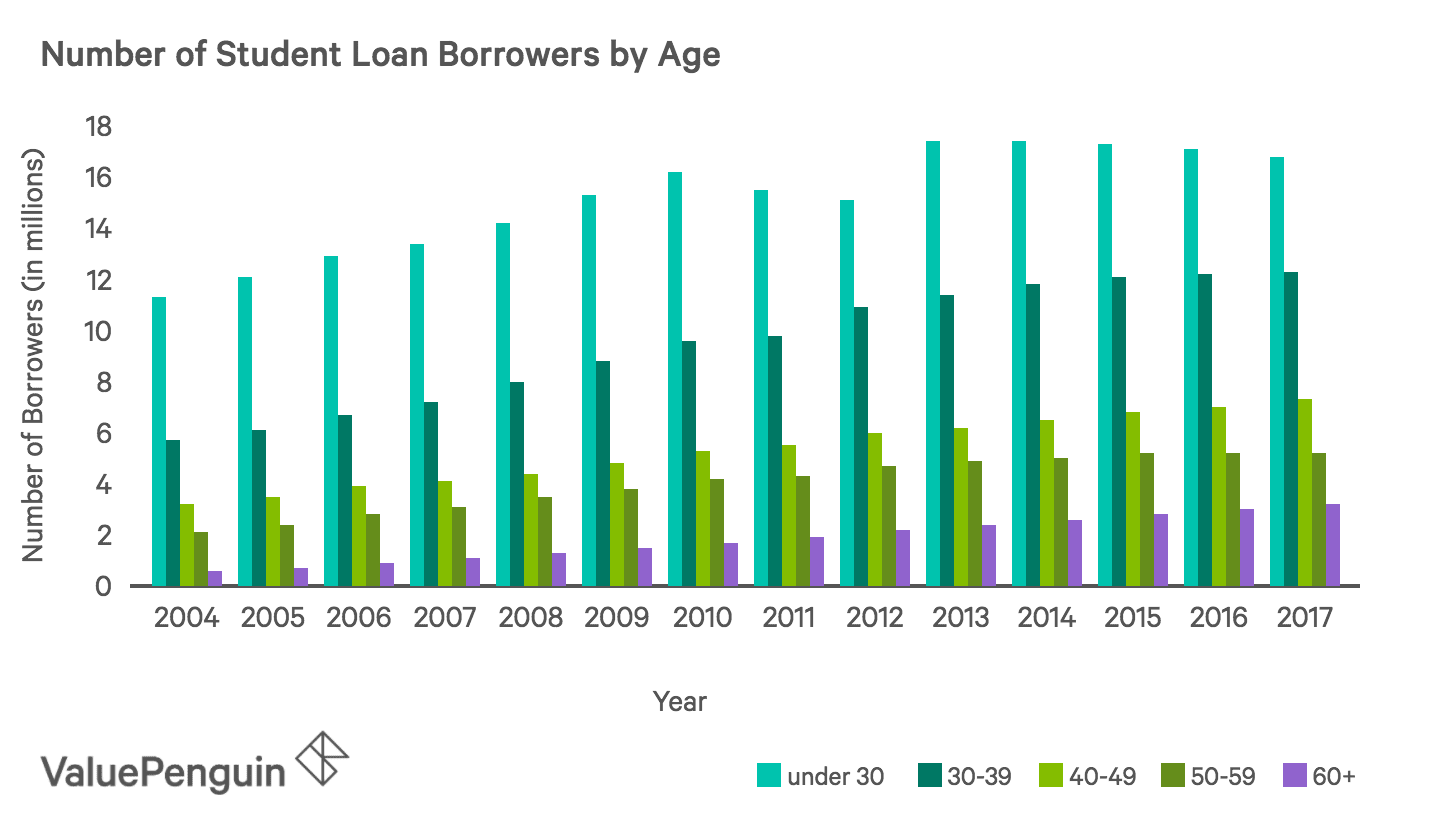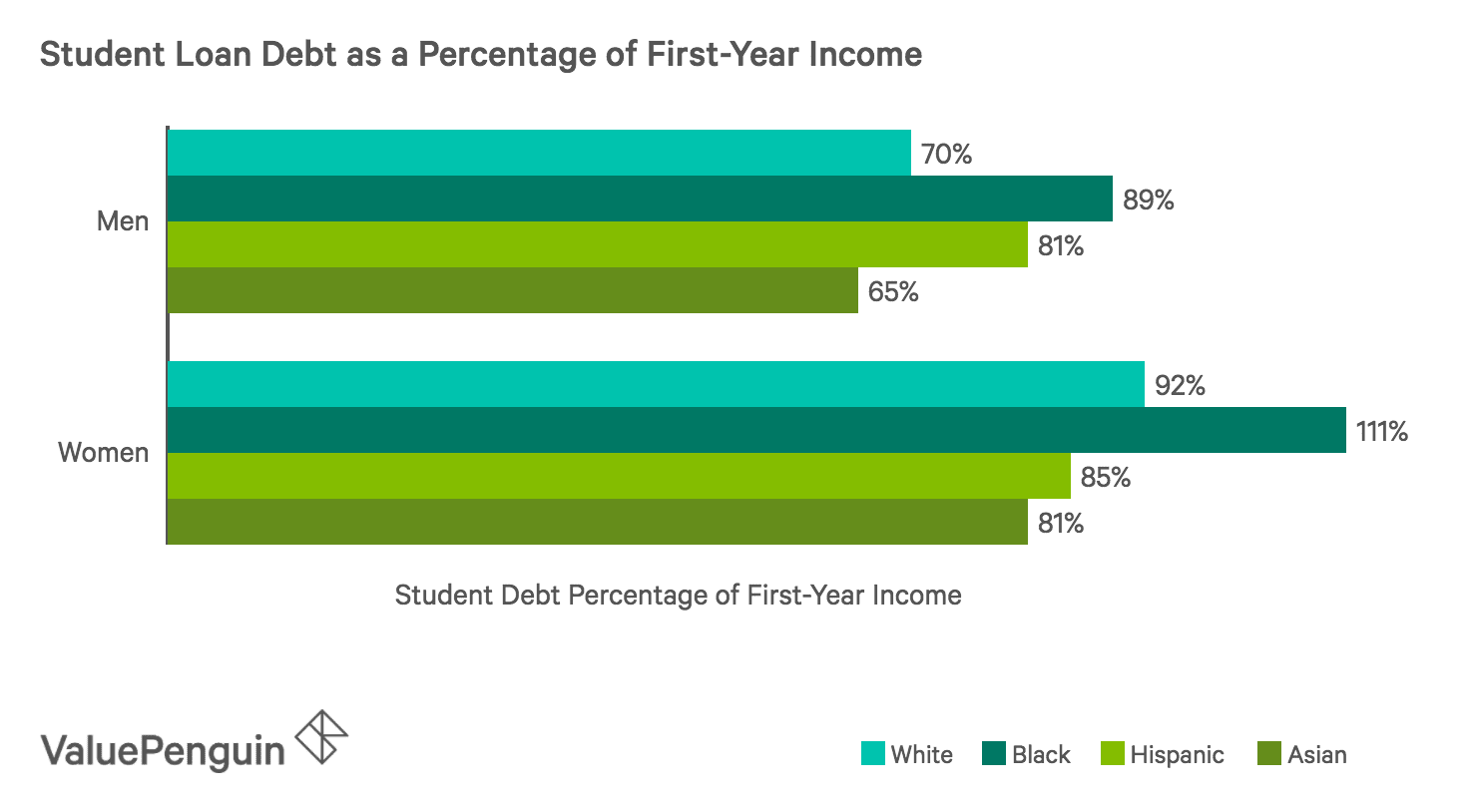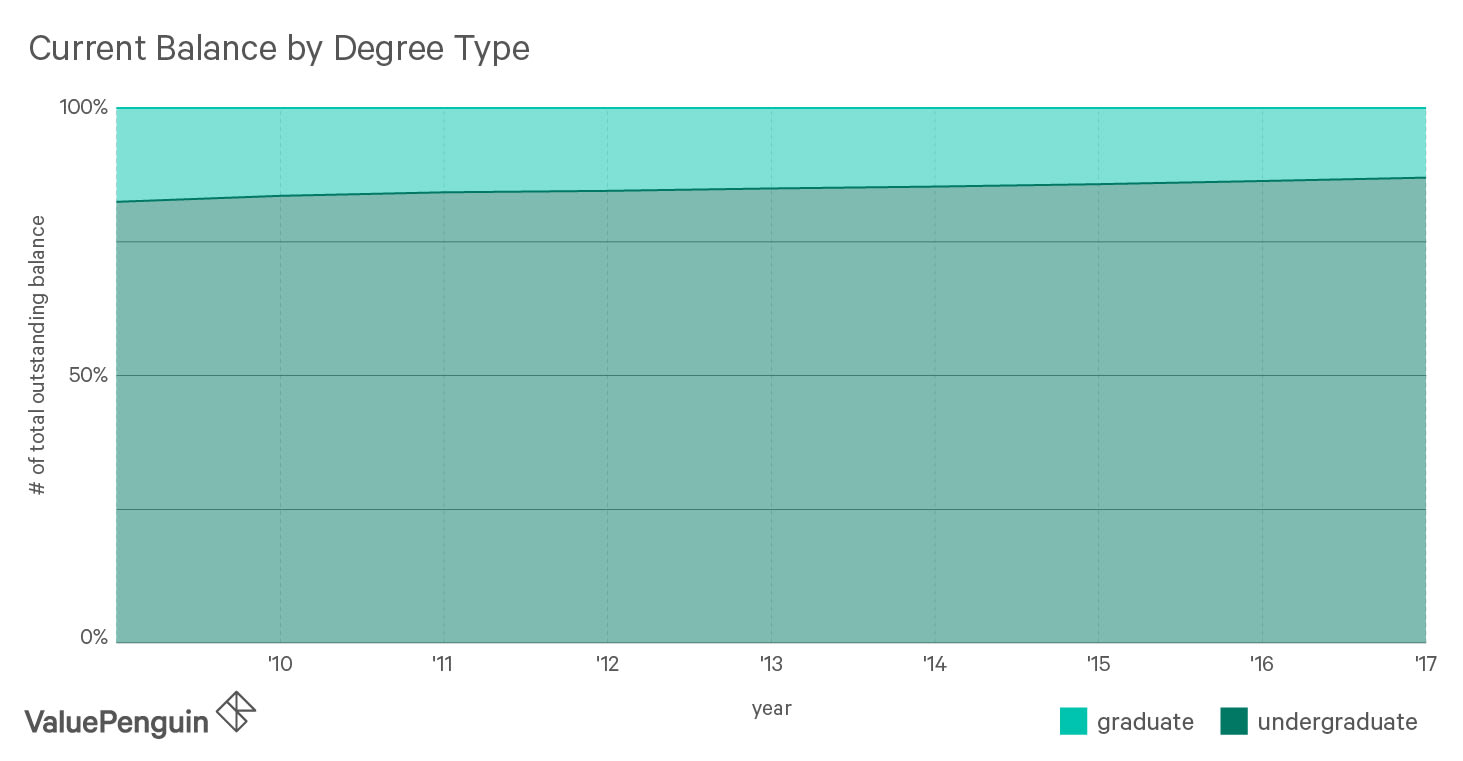Average Student Loan Debt in America: Facts & Figures
The average student debt in the United States is $32,731, while the median student loan debt amount is $17,000. With the rising costs of tuition and total student loan debt up around 302% since 2004, we decided to break down the data to get a better understanding of the different levels of student loan debt across different types of borrowers.
Quick Student Loan Debt Statistics
- Average student loan debt per borrower: $32,731
- Total student loan debt: $1.52 trillion
- Number of student loan borrowers: 44.7 million
- Connecticut has the highest student loan debt for the Class of 2017 at $38,510
- Student loan debt for borrowers 60 and over has increased by 1,256% from 2004
Average Student Loan Debt in The United States
The average college debt among student loan borrowers in America is $32,731, according to the Federal Reserve. This is an increase of approximately 20% from 2015-2016. Most borrowers have between $25,000 and $50,000 outstanding in student loan debt. But more than 600,000 borrowers in the country are over $200,000 in student debt, and that number may continue to increase.

In total, the student loan debt outstanding in the country was $346 billion in 2004, and has ballooned to $1,386 billion as of late 2017. This represents a 302% increase in the total student loan debt in just 13 years. On average, the total student loan balance has increased by $80 billion each year since 2004.
Year | Total Balance | Year-Over-Year Change |
|---|---|---|
| 2004 | $345 billion | - |
| 2005 | $391 billion | 13% |
| 2006 | $481 billion | 23% |
| 2007 | $547 billion | 14% |
| 2008 | $639 billion | 17% |
| 2009 | $721 billion | 13% |
| 2010 | $811 billion | 13% |
| 2011 | $873 billion | 8% |
| 2012 | $965 billion | 11% |
| 2013 | $1,079 billion | 12% |
| 2014 | $1,155 billion | 7% |
| 2015 | $1,231 billion | 7% |
Average Student Loan Debt By State
- Connecticut has the highest average student loan debt for the Class of 2017 at $38,510.
- Utah has the lowest average student loan debt balance at $18,838 and the lowest percentage of residents with student loan debt, 38%.
- 74% of students in New Hampshire, South Dakota and West Virginia from the Class of 2017 have student loan debt.
According to data from The Institute for College Access and Success, the average student loan debt in each state for the class of 2017 is $28,650, ranging from $18,838 to $38,510. And in almost every state, 45% or more students are in debt, besides Utah. The table below shows the average college debt by state with their corresponding rank based on their average debt.
Rank | State | % of Residents with Debt | Average Debt |
|---|---|---|---|
| 8 | Alabama | 50% | $31,899 |
| 40 | Alaska | 46% | $25,682 |
| 44 | Arizona | 54% | $23,967 |
| 34 | Arkansas | 55% | $26,799 |
| 46 | California | 50% | $22,785 |
| 36 | Colorado | 52% | $26,530 |
| 1 | Connecticut | 57% | $38,510 |
| 5 | Delaware | 62% | $34,144 |
| 15 | District Of Columbia | 46% | $30,775 |
| 43 | Florida | 50% | $24,041 |
| 25 | Georgia | 57% | $28,653 |
| 42 | Hawaii | 49% | $25,125 |
*Not enough useable data to calculate averages.
Average Student Loan Debt by Age
- Student loan debt for borrowers 60 and over has increased by 1,256% since 2004, when borrowers in the age bracket had only $6.3 billion in college debt.
- Although there are more student loan borrowers under 30, borrowers between the ages of 30 and 39 have the most student loan debt outstanding.
- Borrowers under 30 accounted for the most student loan debt outstanding until 2014 when it switched to those between 30 and 39.
Looking at the age group breakdowns from the Federal Reserve Bank of New York, there are more borrowers under 30 years of age than there are in any other age bracket. Interestingly from a percentage growth standpoint, the number of borrowers under 30 has not increased much over the last 13 years as it has for the other age groups.

Since 2004, student loan balances across all age groups have increased on average by 302%. The most drastic percentage increase was seen by borrowers over 60 years of age, with a whopping 1,256% student loan balance increase—from $6.3 billion to $85.4 billion—in only 13 years. However, the majority of outstanding student loan balances are held by borrowers in their 20s and 30s, accounting for almost 65% of all student loan debt.
Year | Under 30 (billions) | 30-39 (billions) | 40-49 (billions) | 50-59 (billions) | 60+ (billions) |
|---|---|---|---|---|---|
| 2004 | $147.8 | $112.3 | $48.7 | $29.5 | $6.3 |
| 2005 | $162.4 | $127.6 | $56.4 | $36.4 | $8.2 |
| 2006 | $196.3 | $154.8 | $69.8 | $48.2 | $12.2 |
| 2007 | $219.8 | $174.5 | $80.0 | $56.4 | $15.9 |
| 2008 | $250.9 | $205.4 | $94.4 | $67.6 | $20.4 |
| 2009 | $275.9 | $232.2 | $109.0 | $78.5 | $25.3 |
| 2010 | $301.2 | $261.2 | $128.5 | $89.6 | $30.8 |
| 2011 | $316.4 | $282.0 | $141.7 | $97.0 | $35.4 |
| 2012 | $322.7 | $320.2 | $167.3 | $111.3 | $43.0 |
| 2013 | $362.0 | $354.1 | $188.1 | $124.9 | $49.8 |
| 2014 | $370.5 | $383.1 | $207.6 | $136.5 | $57.7 |
| 2015 | $376.4 | $408.4 | $229.6 | $149.7 | $66.7 |
Average Student Loan Debt by Gender and Race
- Student loan debt balances for African-American women take up 111% of their first-year income.
- Women, in general, have to use a higher percentage of their income to pay student loan debt than men.
- Asian men have the lowest percentage of student loan debt, with their college debt only taking up 65% of their first-year income.
To further our analysis, we took a look at how much student loan debt payments are eating into borrowers’ paychecks after college. This is calculated by taking a person's total student loan debt and dividing that value by their annual income one year post-graduation. On average, student debt balances of African-Americans take up the largest percentage of their first-year income, while Asian-Americans have the lowest percentage.

Federal Student Loan Debt
- The majority of students (29.7 million borrowers) take out direct Stafford subsidized loans from the federal government.
- However, there is a difference of $214.1 billion more outstanding for Stafford unsubsidized loans than its subsidized counterpart.
- The loan type with most total debt outstanding is consolidation loans—with $515.6 billion outstanding for only 11.8 million borrowers.
The majority of student loan borrowers take out loans from the federal government, with a total of 43 million borrowers that have $1,447.1 billion outstanding in student loan debt. Direct loans make up most of that debt, since it includes subsidized, unsubsidized, PLUS and consolidation loans, which we break down in the next table.
Federal Student Debt By Loan Program
Loan Type | Dollars Outstanding | Number of Borrowers |
|---|---|---|
| Direct Loans | $1,163.3 billion | 34.5 million |
| FFEL Loans | $277.0 billion | 13.1 million |
| Perkins Loans | $6.9 billion | 2.2 million |
| Total* | $1,447.1 billion | 43 million |
*Totals may not equal the sum of Direct Loans, FFEL and Perkins Loans due to the timing of when the data runs.
Subsidized and unsubsidized federal student loans account for the bulk of debt outstanding with $767.7 billion combined. However, consolidation loans have the most dollars outstanding compared to all other federal loan types but have much fewer borrowers than subsidized and unsubsidized federal loans.
Federal Student Debt By Loan Type
Loan Type | Dollars Outstanding | Number of Borrowers |
|---|---|---|
| Stafford subsidized | $276.8 billion | 29.7 million |
| Stafford unsubsidized | $490.9 billion | 28.3 million |
| Stafford combined | $767.7 billion | 33.3 million* |
| Grad PLUS | $71.3 billion | 1.5 million |
| Parent PLUS | $89.8 billion | 3.6 million |
| Perkins | $6.9 billion | 2.2 million |
| Consolidation | $515.6 billion | 11.8 million |
*Unique borrowers
Private Student Loan Debt
- The total private student loan debt outstanding for both undergraduates and graduates is $113.2 billion (Q3 2017).
- Private student loan debt has increased by more than 20% since 2014.
-
The percentage of the total outstanding balance from private student lenders is increasing for undergraduates each year.
Private student loan debt has increased each year since 2014, with more students having to take out student loans from private lenders. In just three years, the private student loan debt outstanding has increased by $21.4 billion.
Private Student Loan Debt by Year
Year | Dollars Outstanding |
|---|---|
| 2014 | $91.8 billion |
| 2015 | $99.7 billion |
| 2016 | $102.3 billion |
| 2017 | $113.2 billion |
Undergraduate debt makes up most of the total private student loan debt outstanding, and that percentage has been increasing consistently since 2009. As shown by the graph below, graduate students make up less than 15% of private college debt in the country.
Private Student Debt Balance by Degree Type

Sources:
- New York Fed
- Ticas.org
- Federal Reserve Bank of New York
- studentaid.gov
- MeasureOne Private Student Loan Report
Editorial Note: The content of this article is based on the author's opinions and recommendations alone. It has not been previewed, commissioned or otherwise endorsed by any of our network partners.
